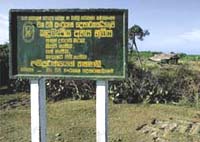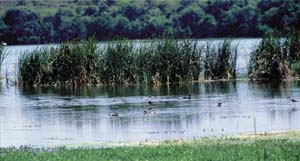 |
 13th June 1999 |
Front Page| |
No, not hereKalametiya villagers are up in arms as the tannery industry threatens a bird sanctuary and their livesBy Dilrukshi Handunnetti
Kalametiya was declared a sanctuary in 1940. The initial declaration included an area wider than the proposed project site, but de-regularisation followed in 1946 to allow the British rulers to go duck hunting- a vintage sport. This precarious legal position existed until 1984 when the two water boundaries of Lunama and Kalametiya were re-gazetted as one sanctuary. History apart, the villagers of Kalametiya are not taking the project thrust upon them kindly. Ango, a 65- year- old weather- beaten fisherman's wife, claims the tanneries would practically ruin their lives. "Our livelihoods are in jeopardy because the tanneries could have a negative effect on fishing as well as farming," she said. Emotions run high among the villagers who view the project as an indirect way of getting the political will of a few implemented. For Andiris (not his real name), this spells disaster.
But the kalapuwa, he is so fond of will soon be filled from one side and the area will undergo drastic changes because of the effluents from the tanneries. He says when the village first heard of the Kalametiya project, the people were filled with happiness and hope which soon turned to heartburn. "We thought there would be more employment and our children could benefit from it. Later we realised all that we were getting was an alien industry of seasoned leather. We don't want that type of industry here," he said. Villagers like Andiris and Ango trudged to city offices to find out the truth. What they found out saddened them. They were told that although originally an area in Puttalam had been identified for the tanneries, it had been abandoned in favour of Kalametiya- the now threatened birds' paradise. The tanneries, being a highly polluting industry will probably discharge various effluents to the nearby lagoon thereby affecting the paddy cultivation and inland fishing- the two main sources of income here. According to Simion, another fisherman, the lagoons have kept the home fires burning at high- tide. " This is so vital and ours is an unpolluted area. We don't want stinking leather and scavenging birds in the area," he said. Farmers like Arnolis Silva have a bone to pick with the authorities. Though they often claim there was an inadequacy of agricultural water in the area they have authorised the daily extraction of 200,000 gallons of lagoon water for the tanneries. Last year, Director Wild Life Conservation Berty Jayasekera gave permission for the water extraction, though subject to conditions. The Memorandum of Understanding signed between the Department and the Ministry of Industrial Development cites a NARA Report to support the view that water extraction would not affect the lagoon and its environs. "This report was never released for public comment. Surprisingly, the report also forgot to mention the detrimental effect the project would have on the aqua culture," noted a spokesman for the Society for Environmental Education, one of the chief agitators against the project. Meanwhile, the Director -General of Irrigation J.T. Wijesooriya had written to the Industrial Development Ministry affirming that the use of the lagoon water for the tanneries would not have adverse effects. Wildlife Director Mr. Jayasekera told The Sunday Times environmental experts have said there would be no repercussions in extracting the water. For the villagers the introduction of tanneries will also affect a certain cultural identity they are fiercely proud of. The inhabitants of Kalametiya and Lunama are mainly Buddhists. Their mindset is not attuned to accepting an animal hide storage as an industry. This plays a major role in their opposition towards the proposed project. C. Wickramage, an expert on leather products said that when the hides get wet they emanate a repugnant odour. "Not the best industry in the midst of any village," he said. According to a co-ordinator of the proposed project, the prepared leather would be transported from the Wanni and Anuradhapura areas. The transportation from such far flung areas is impractical he says. "Tanneries in Puttalam would have been ideal with a direct and closer route to get the seasoned leather. This would be more like a cross country race," he said. Ambalantota Pradeshiya Sabha Chairman Ajith Rajapakse also feels the project location is not perhaps the best. "We are from this district and development is generally welcome. But the problem here is that while failing to provide more water for farming, 200,000 gallons of lagoon water are to be utilised for the tanneries on a daily basis," he said. Fisheries Minister Mahinda Rajapakse believes the project might not generate much employment as it is only a relocation. He also feels it would seriously affect the inland fishing industry. "People will be brought in from Colombo. Therefore there will be no employment opportunities for the villagers," he said, adding that water contamination was also a problem. Meanwhile, The Society for Environmental Studies comprising a group of professionals, in a strongly worded letter has alleged the project stemmed from economic considerations rather than a concern for hydrology. It alleges the project would cause a severe drop in the water level in the lagoon, aggravating the problem of not having a perennial feeder system for Lunama which is dependent on Kalametiya during low tide. It would also affect feeding grounds and habitats, causing salinization of surrounding areas, encroachment by weeds and siltation.
How it beganProject history:The project's origins date back to the late eighties when the move to relocate the Colombo- based tanneries gathered momentum. It was lobbied that Colombo was getting more polluted with industries like leather aggravating the situation. It was then decided to relocate the tanneries in a remote, uninhabited area. Though the original proposal envisaged Puttalam, Kalametiya was later proposed as an ideal site. A presidential directive has been given to relocate the tanneries, but there has been no risk analysis on the ground situation or a general discussion with residents. Environmental implications:According to leading environmentalists, water contamination and air pollution are two grave threats in addition to the threat to bird life. Environmental lawyer Jagath Gunawardene alleges the project would put invaluable bird life in jeopardy while effluent discharge would cause water contamination. Mr. Gunawardene says the mangroves, salt vegetation and the massive wetlands of the area are of great ecological importance. Around 200 hectares each in Lunama and Kalametiya will be absorbed by the project with the possible destruction of the habitat of around127 bird species. The great pelican, a globally threatened species,the glossy and gray ibis, the purple heron, egrets, cormorants, ducks and waders like the gargeny, the fintail and resident ducks abound in Kalametiya. Mr. Gunawardene said that the stench from the soaked hides would disturb breeding and affect the birds' habitat. "It would also create a new problem of scavenger birds, threatening nests, the young and eggs," he said. He says when the area was declared a RAMSAR site in 1996, a strict protection mechanism should have been implemented. "Contamination and toxic metal use are other problems that could arise. That is why we insist on a risk analysis," he said. |
||
 |
Front Page| News/Comment| Editorial/Opinion| Business| Sports | Mirror Magazine |
|
 |
Please send your comments and suggestions on this web site to |
|
 For
the people of Kalametiya, in arid Hambantota the tranquility of their lives
seems destined to be short-lived. For these people, eking out a threadbare
existence, the proposed relocation of tanneries to their part of the world
spells destruction of their rural culture, and more significantly, their
livelihood.
For
the people of Kalametiya, in arid Hambantota the tranquility of their lives
seems destined to be short-lived. For these people, eking out a threadbare
existence, the proposed relocation of tanneries to their part of the world
spells destruction of their rural culture, and more significantly, their
livelihood. "We
gave our life- blood to the fishing industry, and this area is full of
fisher people and farmers. The kalapuwa (lagoon) is a treasured part of
our childhood," he says nostalgically adding it was to this lagoon
they turned to when deep sea fishing became impossible during high tide,
known as the warakan period.
"We
gave our life- blood to the fishing industry, and this area is full of
fisher people and farmers. The kalapuwa (lagoon) is a treasured part of
our childhood," he says nostalgically adding it was to this lagoon
they turned to when deep sea fishing became impossible during high tide,
known as the warakan period.